Resident Crews of the International Space Station (ISS)
![]()
ISS: Expedition 13 |
 |
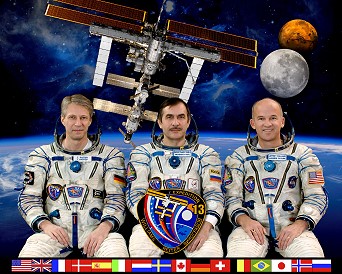
alternative crew photoalternative crew photoalternative crew photo |
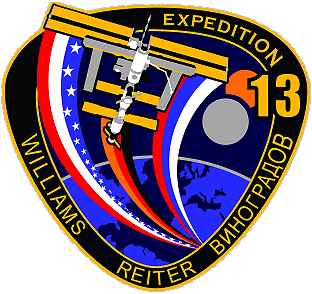 |
 |
|
![]()
Crew, launch- and landing data
| No. | Nation | Surname | Given names | Position | Spacecraft (launch) |
Launch date |
Launch time |
Spacecraft (landing) |
Landing date |
Landing time |
Mission duration |
Orbits |
| 1 | Vinogradov | Pavel Vladimirovich | ISS-CDR | Soyuz TMA-8 | 30.03.2006 | 02:30:20.076 UTC | Soyuz TMA-8 | 29.09.2006 | 01:13:37 UTC | 182d 22h 43m 17s | 2886 | |
| 2 | Williams | Jeffrey Nels | Flight Engineer-1 | Soyuz TMA-8 | 30.03.2006 | 02:30:20.076 UTC | Soyuz TMA-8 | 29.09.2006 | 01:13:37 UTC | 182d 22h 43m 17s | 2886 | |
| 3 | Reiter | Thomas Arthur | Flight Engineer-2 | STS-121 | 04.07.2006 | 18:37:54.987 UTC | STS-116 | 22.12.2006 | 22:31:58 UTC | 171d 03h 54m 03s | 2692 |
Backup Crew
| No. | Nation | Surname | Given names | Position |
| 1 | Yurchikhin | Fyodor Nikolayevich | ISS-CDR | |
| 2 | Fincke | Edward Michael "Mike" | Flight Engineer | |
| 3 | Eyharts | Léopold Paul Pierre | Flight Engineer |
 |
Expedition Report
|
Launch from the Baikonur Cosmodrome (Pavel
Vinogradov and Jeffrey
Williams); Thomas
Reiter arrived with
STS-121 in July
2006. The Expedition 13 officially began with undocking of Russian spacecraft Soyuz TMA-7 on April 08, 2006 at 20:27:54 UTC and Expedition 12 ended. Following a two-day solo flight Soyuz TMA-8 docked to ISS on April 01, 2006. Astronaut Marcos Pontes launched with Expedition 13 on the Soyuz TMA-8 spacecraft and became the first Brazilian in space. He returned with Expedition 12 on Soyuz TMA-7 after a nine-day mission. The Missão Centenário started after a deal of between the Brazilian Space Agency and Roscosmos in October 18, 2005. its main goal was to make possible the flight of Marcos Pontes, the first Brazilian in space. The Missão Centenário costed US$10 million for the Brazilian Space Agency (or R$ 10,000 by Brazilian by the year of 2010) and happened during the Brazilian participation in the ISS Program. The name is in reference the celebration from the centennial of the 14-Bis flight of Santos-Dumount in Paris, October 23, 1906. During his mission, Marcos Pontes executed 8 Brazilian experiments: - Microgravity Enzymes Kinetics (FEI): its goal was to study the micro gravity effects in two enzymes: Lipase and Invertase. Each enzyme was tested in different levels of reagents with a total of 15 mixings; - DRM - DNA Repair in Microgravity (UERJ and INPE): Investigation of the Effects of High Levels of Radiation on DNA Repair Mechanisms in Microgravity; - Capillary Evaporator in Microgravity (UFSC): The experiment consists of a capillary evaporator mounted on a biphasic heat transfer circuit using de-ionized water as the working fluid. It is designed for application oriented to the cooling of satellites or of space probes. One main result was that the equipment worked in micro gravity in the same way as in the Earth, making possible to conclude that it can be used for thermal control in micro gravity hardware. - MHP - Mini Heat Pipe (UFSC): Device developed for allow the flow of high levels of temperature, even when under a small level of temperature. - GSM - Germination in Microgravity (EMBRAPA): the goal was to evaluate the micro-gravity, illumination and radiation effects in seeds of Astronium fraxinifolium/schott. - NIP - Protein Interaction Clouds (CenPRA/MCT): its goal was to study the interaction of atomized bio-luminescent enzymes in micro gravity. - Germination of common bean seeds (Secretaria Municipal de Educação de São José dos Campos-SP): the experiment evaluated the defects of water, light and micro gravity on the germination of beans seeds (Phaseplus Vulgaris). Was executed in sync between the ISS and four municipal schools in São José dos Campos. The main goal was to make the students participate with interest in the experiment, what really happened. - Observation of the Chlorophyll Chromatography Process in Weightlessness (Secretaria Municipal de Educação de São José dos Campos-SP): also executed with the schools, the goal was to observe the separation of the pigments from the leaf of Brassica oleracea through chromatography and see the results side with the school experiments in São José dos Campos. Thomas Reiter, from the European Space Agency, became part of the Expedition 13 crew in July 2006. Thomas Reiter was launched with the second "Return to Flight" mission on Discovery (STS-121) on July 04, 2006. Thomas Reiter became the first European long-duration crew member on the International Space Station when he officially joined the crew of the ISS at 19:13 UTC on July 06, 2006 upon the complete installation of his Soyuz spacecraft seat liner, allowing him to return to Earth aboard the docked Soyuz craft. Progress M-56 was launched at 16:03:25 UTC on April 24, 2006. The spacecraft docked with the Aft port of the Zvezda module at 17:41:31 UTC on April 26, 2006. Progress M-56 carried supplies to the International Space Station, including food, water and oxygen for the crew and equipment for conducting scientific research. The freighter remained docked for five months before undocking at 00:28:17 UTC on September 19, 2006 to make way for Soyuz TMA-9. It was deorbited at 03:28 UTC on September 19, 2006. The spacecraft burned up in the atmosphere over the Pacific Ocean, with any remaining debris landing in the ocean at around 04:14:40 UTC. The first EVA by Pavel Vinogradov and Jeffrey Williams occurred on June 01, 2006 (6h 31m) to install a new hydrogen vent valve on the hull of the Zvezda Service Module to bypass a similar valve that is clogged, to recover a thruster residue collection device from Zvezda, to retrieve a contamination monitoring device and a package of biology experiments and reposition a cable for a navigation antenna on the aft end of Zvezda, to replace a camera on the station's Mobile Base System. Progress M-57 was launched at 15:08:18 UTC on June 24, 2006. The spacecraft docked with the Pirs module at 16:25 UTC on June 26, 2006. Progress M-57 carried supplies to the International Space Station, including food, water and oxygen for the crew and equipment for conducting scientific research. The freighter remained docked for five and a half months before undocking at 23:23:52 UTC on January 16, 2007 to make way for Progress M-59. It was deorbited at 02:29 UTC on January 17, 2007. The spacecraft burned up in the atmosphere over the Pacific Ocean, with any remaining debris landing in the ocean at around 03:15:20 UTC. On July 06, 2006 Space Shuttle STS-121 docked with the International Space Station. The main purposes of the mission (ISS ULF-1.1) were to test new safety and repair techniques introduced following the Columbia disaster of February 2003 as well as to deliver supplies, equipment. Discovery delivered with ESA astronaut Thomas Reiter a third crew member to live aboard the station as part of Expedition 13. It was the first time a three-person crew resides on station for a long duration since the Expedition 6 crew returned to Earth May 04, 2003, in Kazakhstan. Without the space shuttle to ferry equipment to the station after the Columbia accident, only two people could be supported onboard until the necessary provisions were in place. To help deliver tons of supplies, Discovery carried an Italian-built pressurized cargo container called Leonardo, in its cargo bay. The docking set the stage for the opening of the hatches and the start of joint operations, including the transition of Thomas Reiter to the Expedition 13. International Space Station Flight Engineer Thomas Reiter, representing the European Space Agency (ESA), flew to the space station aboard Discovery. He had to lead the transfer of supplies from the shuttle's cargo module to the space station during the spacewalks and he assisted with suit-up prior to the spacewalks. He was conducting his second long-duration spaceflight mission. He spent 179 days in space in 1995-1996 on a mission to the Russian MIR space station during which he conducted two spacewalks and about 40 European scientific experiments. Thomas Reiter was the first ESA astronaut to live aboard the International Space Station for a long-term mission. Thomas Reiter worked on the station as part of an agreement between the Russian Federal Space Agency and ESA. Thomas Reiter remained on the space station until the STS-116 space shuttle. The Leonardo cargo carrier housed in Discovery's payload bay was berthed to the space station Unity module's Earth-facing port on flight day 4. This was the fourth trip to the station for Leonardo, the first of three such Italian-built cargo carriers to be put into service. Leonardo flew to space for the first time aboard Discovery during STS-102 in February 2001. The Multi-Purpose Logistics Module Leonardo was mated to the space station's Unity module. It was carrying: - 80 °C Freezer. This freezer is known as the Minus Eighty Degree Laboratory Freezer for ISS (MELFI). The French built unit comprises four independent drawers which can be set to operate at different temperatures. Initially, temperatures of -80 °C, -26 °C, and +4 °C will be used during on-orbit ISS operations. Both reagents and samples will be stored in the freezer. As well as storage, the freezer is designed to be used to transport samples to and from the ISS in a temperature-controlled environment. The total capacity of the unit is 300 liters. - The European Modular Cultivation System (EMCS) for biological experiments. This consists of a gas tight incubator in which there are two centrifuges, each able to carry four experimental cartridges. Two "Ground controls" - exact copies of the equipment and experiments - will be run on the ground, one in Europe and one at NASA's Ames Research Center. - New oxygen generation system. This device is considered a test for an equipment design with potential for use on proposed future long durations to the Moon and Mars. The system will initially run below its maximum capacity, though it is designed for enabling the ISS to support a crew of six in the future. It will supplement the Russian-built Elektron system operating in the Zvezda module. - New cycling machine for the ISS crew. A Danish built device, the Cycle Ergometer with Vibration Isolation System (CEVIS). - Replacement common cabin air assembly heat exchanger used to control the internal air temperature of the ISS. Also carried in the payload bay: an Integrated Cargo Carrier with the Trailing Umbilical System (TUS) for the Mobile Transporter (returning old one); an EATCS/Pump Module (PM); and 2 Fixed Grapple Bars for PM & TUS relocation during EVA, as well as an LMC carrying the DTO-848 TPS Repair Box. The first EVA was performed by Piers Sellers and Michael Fossum on July 08, 2006 (7h 31m) for maintenance on the station's mobile transporter and a test of astronaut movement on the end of the robotic arm boom extension for possible heat shield repairs during future flights. During the first spacewalk, the crew members tested the 50-foot (15 meters) robotic arm boom extension, usually used for remote shuttle thermal protection system (TPS) inspections, as a potential work platform for hard-to-reach repair sites on the bottom of the orbiter for detailed test objective (DTO) 849. They also began maintenance of the station's mobile transporter (MT) by saving or replacing a cable cutter and routing a cable on the MT to allow it to be moved before the second spacewalk. The cable cutter, called an interface umbilical assembly (IUA), is on the top, or zenith side of the MT. A duplicate device on the Earth-facing, or nadir side, of the MT inadvertently cut the nadir cable in December 2005. The crew first worked on keeping the zenith IUA from activating in the future by either installing a device to block the cutter from the cable or remove the IUA and replaced it with a new unit launched on Discovery. The Expedition 12 crew had tried to safe the zenith IUA during a spacewalk in March 2006 by installing a saving bolt, but the bolt could not be inserted. To prevent the cable from being inadvertently cut, that crew removed it from the IUA until the STS-121 crew could work on it. Piers Sellers and Michael Fossum re-routed the Trailing Umbilical System (TUS) cable through the IUA, once it is configured safely, to allow the MT to be moved from worksite 4 (WS4) to worksite 5 (WS5 on the station's truss) in advance of EVA 2. The next objective of the spacewalk, was to test the new robotic boom as an orbiter tile inspection or repair work platform. For the test, first Piers Sellers and then both crew members, worked on the end of the boom. They simulated repair-related movements in at least three different OBSS positions. Sensors installed on the OBSS and imagery from various cameras provided post-flight information to engineers that helped them evaluate the stability of the boom. Much of the test was dedicated to setting up tools and the OBSS for the movements and then reconfiguring at the end. The movements of the spacewalkers for the tests in the three arm positions were scheduled to take about 30 minutes each. The spacewalkers provided comments about each movement, while the sensors in the load cell recorded quantitative data for review following the mission. After leaving the Quest airlock, Piers Sellers and Michael Fossum first saved the zenith IUA as described above. Then they moved to the pressurized mating adapter (PMA) 1 to retrieve an articulating portable foot restraint (APFR) with a tool stanchion (TS). Next, they worked their way down to Discovery's payload bay, hand-over-hand to setup for the test. Once in the payload bay, Piers Sellers temporarily placed the APFR/TS on the integrated cargo carrier (ICC) and Michael Fossum configured it. Piers Sellers then continued set up by deploying a sensor, called a load cell or instrumented worksite interface fixture (IWIF), which he installed later on the OBSS. Commander Steven Lindsey used a laptop computer inside Discovery, with an RF antenna installed, to activate the sensor. Lisa Nowak and Stephanie Wilson then moved the shuttle's robotic arm so that the end of the OBSS/SRMS hovers above the starboard sill of the payload bay. There, Piers Sellers installed several safety tethers onto the OBSS. Lisa Nowak and Stephanie Wilson then moved the tip of the OBSS to just above the starboard sill of the payload bay. Piers Sellers installed the activated load cell and a portable foot restraint attachment device (PAD). Since this was the first time that crew members interact directly with the OBSS, Michael Fossum was on hand to physically stabilize the OBSS any time Piers Sellers is performing setup and cleanup activities with it. Next, Piers Sellers and Michael Fossum worked together to move the APFR/TS onto the top of the load cell now on the tip of the OBSS. Piers Sellers extended the TS and ingressed the APFR. With setup complete, Lisa Nowak and Stephanie Wilson maneuvered the robotic boom into the first test position, with Piers Sellers riding at the end of the OBSS. Michael Fossum stayed in the payload bay and took digital photos during the first test. For the first position, the end of the boom is about 14 feet (4.3 meters) from the payload bay, directly above the position where Piers Sellers got on the boom. Once the boom was in place, Piers Sellers performed several movements to simulate real inspection or repair actions. The positions simulated movement of a crew member on the tip of the boom during translation to, and while inspecting a potential damage site on the bottom of the orbiter. They included Piers Sellers simulating taking photographs, laying back slightly to retrieve a tool behind him, reaching for equipment in front of him, and making positional changes to the APFR and TS. The second position, where Piers Sellers performed additional movements, had the end of the OBSS extending about 27 feet (8.2 meters) to the port and aft of Discovery's payload bay. This position had the SRMS joints in a slightly "weaker" configuration which should result in larger OBSS deflections. Piers Sellers went through three sets of movements similar to the movements at the first test position. Michael Fossum repositioned himself in the payload bay to watch and document the second round of tests. Once the tests in the first position, and second, were complete, Lisa Nowak and Stephanie Wilson moved the OBSS back to above the sill of the payload bay where Michael Fossum was waiting. There, Piers Sellers moved off the APFR so Michael Fossum could get on. Then Piers Sellers hang onto the TS and both tethered themselves in place. Lisa Nowak and Stephanie Wilson then moved the OBSS into an intermediate position and then the third test position. In the third position the end of the OBSS is 16 feet (4.9 meters) in front of the station's P1 truss segment. The configuration of the SRMS joints provides a similar "weakness" to those of position 2. The main difference was that both crew members were now on the tip of the OBSS. During the position 3 evaluations, Michael Fossum made gestures similar to what Piers Sellers did at the first two positions with Piers Sellers now also on the boom. Both crew members moved simultaneously for some of the test. Once the movements at the third test position were complete, Lisa Nowak and Stephanie Wilson moved the end of the OBSS with both Michael Fossum and Piers Sellers toward the station's P1 truss segment for the final set of tests. At this test position Michael Fossum simulated repair movements on the P1 truss structure. The P1 truss was selected to represent a TPS damage location somewhere on the orbiter that would need repair. This specific location was chosen because of the SRMS joints that are necessary to reach it. Once again, the joints provide a "weak" configuration that allows for larger OBSS tip deflections. The data resulting from using a "weaker" configuration were expected to provide the best information in order to gauge the capability of performing a real repair from the OBSS. The movements performed by Michael Fossum simulated applying tile repair material with an emittance wash applicator (EWA), drilling on an RCC panel, and using a spatula with repair material on an RCC panel. Once the testing was done in the final OBSS position, Lisa Nowak and Stephanie Wilson moved the arm so the spacewalkers could egress onto Discovery's payload bay sill. With Michael Fossum's assistance, Piers Sellers had to cleanup the end of the OBSS by removing the APFR/TS, load cell, PAD and safety tethers. The equipment was taken back to the airlock with the spacewalkers. Once the OBSS was reconfigured, the arm was moved higher above the payload bay out of the way. The second EVA by Piers Sellers and Michael Fossum occurred on July 10, 2006 (6h 47m) for installation of a spare thermal control system pump on to the outside of the Quest Airlock and replacement of reel assembly for a cable that provides power and data to the station's mobile transporter. The second EVA consisted of installing the thermal control system's spare pump module and replacing the nadir Trailing Umbilical System - Reel Assembly (TUS-RA). The TUS provides power, data and video to the MT. During EVA 1, the crew re-routed the zenith TUS cable thru the zenith IUA to allow the TUS to be moved from position WS4 to WS5. Before EVA 2, the MT must be moved from WS4 to WS5 because its current position makes it difficult for the crew to change out the nadir TUS-RA. At the start of EVA 2, both crew members translated down to the payload bay and prepared the pump module for transfer. The first activity was for Michael Fossum and Piers Sellers to take the fixed grapple bar (FGB) from the underside of the ICC and install it onto the pump module. The FGB allowed Lisa Nowak and Stephanie Wilson to latch onto the pump module with the station's robotic arm and moved it to the worksite at the external stowage platform 2 (ESP 2) for installation. Once the FGB was installed, the crew released the pump module from the ICC and lifted it up to present it to the robotic arm. During the arm's maneuver, Piers Sellers and Michael Fossum began preparation for removing and replacing the TUS-RA. First, they prepared the payload bay by relocating some APFRs and opening the TUS multi-layer insulation (MLI) cover. Then, they translated to the starboard zero (S0) truss segment, located above the Destiny Lab. Michael Fossum prepared the old TUS-RA for removal by releasing electrical connectors and bolts, while Piers Sellers changed out the nadir IUA in preparation for routing the new TUS cable. Once complete, they both translated to ESP 2 to install the pump module. Lisa Nowak and Stephanie Wilson presented the pump module with the robotic arm. Once Piers Sellers and Michael Fossum had a hold, the arm released it and moved away so the pump module could be set on ESP 2 and bolted in place. Next, Michael Fossum configured the robotic arm with an APFR and, along with Piers Sellers, released and removed the old TUS from S0. Michael Fossum, now mounted on the robotic arm, was maneuvered down to the payload bay. Because this maneuver took some time, Piers Sellers translated to the payload bay and finished preparation tasks for removal of the new TUS-RA. Once both were ready, Piers Sellers got into an APFR on the ICC and Michael Fossum handed Piers Sellers the old TUS-RA. Michael Fossum then maneuvered to the new TUS-RA, removed it from its launch location and returned to Piers Sellers to swap the 330-pound TUS-RAs. Michael Fossum handed Piers Sellers the new TUS-RA - Piers Sellers had a one in each hand - and then Piers Sellers handed Michael Fossum the old TUS-RA. Michael Fossum put the old reel assembly on the carrier and retrieved the new one from Piers Sellers. Michael Fossum, who was still on the end of the robotic arm, took the new TUS-RA and began to maneuver up to S0 to install it. Piers Sellers completed installation of the old TUS onto its stowage location with the flight support equipment, and then translated back up to S0. Together they installed the new TUS-RA into S0 and routed the new cable to the nadir IUA. With the EVA complete, there were both a zenith and nadir TUS, assuring redundancy for operation of the Mobile Transporter. The third and final EVA by Piers Sellers and Michael Fossum was conducted on July 12, 2006 (7h 11m) to demonstrate on orbit heat shield repair techniques. After leaving Quest, Piers Sellers and Michael Fossum had to setup tools on the end of the station's robotic arm, Canadarm2. Piers Sellers installed an APFR on the end of Canadarm2. Michael Fossum handed him supplies and tools to attach, including a CRM bag and an Infrared camera. Piers Sellers used the infrared (IR) camera as part of DTO 851 to take about 20 seconds of IR video of RCC panels on Discovery's wing leading edge while being transported on the end of Canadarm2 to Discovery's payload bay. The FLIR Systems ThermaCAM S60 Infrared Camera is being assessed as a way to inspect RCC for damage on-orbit. Depending on how far away the crew member is, the camera's field of view can cover 52 inches (132 centimeters), or about two RCC panels, to 83 feet (25.3 meters), the entire wing leading edge at a time. The camera can record temperature variances from minus 400-degrees Celsius to 1,200-degrees Celsius. The video is recorded at a 0.6 Hz frame rate and is saved on internal memory and then transferred to a memory card. Meanwhile, Michael Fossum travelled hand-over-hand to the cargo bay and began setting up the worksite. The two worked side-by-side to test repair techniques on a pallet of pre-damaged RCC samples. The pallet included twelve RCC samples. Eight had various sized cracks and/or gouges, two were blank slates or "palettes" to be used during repairs of the other samples, and two were pre-damaged samples to be imaged with the IR camera. There were more samples for the crew members to work with than what is required or expected to be completed. The pallet was located in the aft portion of Discovery's cargo bay. Michael Fossum had to setup another APFR to position himself next to the pallet and opened the pallet's lid. Once in the cargo bay, Piers Sellers got off the robotic arm to attach the CRM bag to the inside of the pallet's lid and then got back on the arm to begin the repair work. The RCC crack repair tasks for DTO 848 involved using a pre-ceramic polymer sealant impregnated with carbon-silicon carbide powder, together known as NOAX (short for non-oxide adhesive experimental). The NOAX material is temperature sensitive and the ideal condition for the repairs is when the samples are between 100 and 35 degrees Fahrenheit (37.8 and 1.7 degrees Celsius), with the temperature decreasing. Therefore, the crew members were scheduled to work on the crack repairs with the NOAX material during night portions of their orbit, beginning the repair just after orbital sunset. Once setup for the spacewalk was complete, if the temperature readings were acceptable, the crew began repairing a cracked or gouged RCC sample. For the tests, Michael Fossum assisted Piers Sellers as he used a space-hardened caulk gun to dispense the NOAX material. Using one of three manual caulk guns in the crack repair kit, he dispensed the material directly onto the sample. He then used one of many spatulas, similar to a putty knife, to work the crack repair material into the pre-damaged RCC sample mounted in the DTO pallet. Additional layers then were added to the repair by first extruding the material onto the nearby RCC palettes. He then used the spatula to manipulate the material onto the sample being repaired. Piers Sellers and Michael Fossum continued repairing the remaining cracked samples with the NOAX material. If at least the two highest priority RCC impact damage samples had been repaired, there was an additional task for DTO 851 for the crew to complete. It involved taking about 60 seconds of video with the IR camera of two damaged RCC samples on the pallet. Piers Sellers used the IR camera to record a temperature gradient throughout each RCC sample itself. As with the actual RCC repair tasks, it was preferred that the temperature is dropping. Therefore, the best imaging occurred by Piers Sellers starting the imaging during direct sunlight and then about 10 seconds later he shaded the samples to provide the desired temperature gradient. The astronauts also continued cargo transfers between the shuttle, the International Space Station and the Leonardo multi-purpose logistics module. Leonardo arrived with more than 7,400 pounds (3,357 kg) of equipment and supplies for the station. Leonardo was returned to the payload bay packed with more than 4,300 pounds (1,950 kg) of science experiment results, unneeded items and trash. On July 15, 2006 STS-121 undocked and backed away from the ISS to a distance of about 450 feet (137.2 meters), where Mark Kelly initiated the first of two separation burns to fly the shuttle above the station. A full flyaround of the station was no planned to conserve time for further inspections of Discovery's heat shield. Once directly above the station, Mark Kelly fired Discovery's jets to leave the station area. Discovery held station keep at a distance of 40 nautical miles (74 km) from ISS until the late inspection imagery was reviewed and the Mission Management Team cleared the orbiter for landing. This position allowed Discovery the opportunity to redock to the station if needed. The second and final station EVA was performed by Jeffrey Williams and Thomas Reiter on August 03, 2006 (5h 54m) to install items of hardware in preparation for future ISS assembly work and set up for deployment a number of instruments and experiments mounted on the outside of the Station. During the spacewalk the astronauts installed the Floating Potential Measurement Unit (FPMU), installed two Materials on Materials International Space Station Experiment (MISSE) containers, installed a controller for a thermal radiator rotary joint, replaced a computer and installed a starboard jumper and spool positioning device (SPD), inspected a radiator beam valve module and installed another, installed a port jumper and SPD, tested an infrared camera, installed a light on the truss railway handcart, replaced a malfunctioning GPS antenna, installed a vacuum system valve, moved two articulated portable foot restraints, photographed a scratch on the airlock hatch, and retrieved a ball stack for inspection from PMA-1. STS-115 arrived at the International Space Station on September 11, 2006. The mission STS-115 (ISS-19-12A ITS-P3 / ITS-P4) delivered the second port-side truss segment (ITS P3/P4), a pair of solar arrays (2A and 4A), and batteries. A total of three spacewalks were performed, during which the crew connected the systems on the installed trusses, prepared them for deployment, and did other maintenance work on the station. It was the first time in almost four years that a major new space station component, the 17.5-ton, bus-sized P3/P4 integrated truss section, has been launched. Atlantis' approach to the International Space Station during the STS-115 rendezvous and docking process included a tricky maneuver first demonstrated on STS-114 and repeated during the STS-121 mission. The orbiter was commanded to conduct a back-flip pirouette, enabling station crew members to take digital images of the shuttle's heat shield. When Atlantis arrived at the station two days after its launch, the six-person shuttle crew was greeted by the three-man Expedition 13 crew. Russian Commander Pavel Vinogradov and Flight Engineer and NASA Science Officer Jeffrey Williams have been aboard the complex since April 01, 2006 following their launch on the Soyuz TMA-8 spacecraft from the Baikonur Cosmodrome in Kazakhstan. They were scheduled to return to Earth in late September following the arrival of the next station crew, Expedition 14, which launched in Soyuz TMA-9 spacecraft right after the STS-115 mission. The third member of the Expedition 13 crew is European Space Agency astronaut Thomas Reiter who arrived at the outpost on the STS-121 mission. He remained on board with the Expedition 14 crew through the end of the year 2006. Following docking, Christopher Ferguson and Daniel Burbank attached the shuttle's robotic Canadarm to the 17.5-ton P3/P4 truss, lifted it from its berth in the payload bay, and maneuvered it for handover to the station's Canadarm2. The P3/P4 truss segment provides an additional photovoltaic module (PVM) with two power channels (2A and 4A), the port Solar Alpha Rotary Joint (SARJ) and two Unpressurized Cargo Carrier Attachment System sites. The P3/P4 segment is 45.3 ft (13.8 meters) long and weighs 34,885 pounds (15,823 kg). The P3 structure has an elongated hexagonal cross section with two bays arrayed along the long axis. The P4 truss segment is integrated to the P3 segment before flight. The Solar Alpha Rotary Joint (SARJ) enables the new outboard solar arrays to always point to the sun by rotating like a Ferris wheel. The port SARJ on P3/P4 provides tracking for the P4 and P6 solar arrays once P6 is relocated to P5 on the STS-120 mission. The starboard SARJ for the S3/S4 arrays, to be delivered on STS-117, will provide tracking for the S4 and S6 solar arrays once S6 is installed on the STS-119 mission. The SARJ can rotate 360 degrees clockwise and counterclockwise. The SARJ also provides the structural interface between the P3 or S3 and P4 or S4 elements. It includes hardware to route power and data through the rotating SARJ interface to the outboard truss segments. The SARJ includes an inboard and an outboard race ring, which provide the structural connection between the P3 and P4 elements. Along the circumference of each race ring are gear teeth that mesh with the drive lock assembly (DLA) pinion gear to rotate the SARJ. The outboard race ring is used by the DLA for rotating the SARJ. The 12 equally-spaced trundle bearings hold the SARJ inboard and outboard race rings together. Each trundle bearing is fixed to the inboard race ring and is clamped onto the outboard race ring with a roller interface to allow for SARJ rotation. There are three rollers on the trundle bearing that interface with the outboard race ring; the inner and outer upper rollers and the center roller. Each roller consists of two bearings: the primary and journal bearings. The primary bearing rotates. If the primary bearing seizes up, the journal bearings will begin rotating. The journal bearing is designed to operate for about 30 days. There are micro-switches in the trundle bearing that allow the ground to know if the journal bearing is rotating. Two Drive Lock Assemblies (DLAs) are responsible for rotating and locking the SARJ. Each DLA includes the engage-disengage mechanism (EDM) motor, drive motor, pinion gear, lock rack and two follower arms. The EDM motor is a stepper motor that pivots the lock rack and pinion gear about the lock/engage pivot point to the desired position. The DLA positions are locked, engaged and neutral. For the locked position, the lock rack is in contact with the race ring gear teeth to prevent the SARJ from rotating. For the engaged position, the DLA pinion gear is meshed with the race ring gear to rotate the SARJ with the drive motor. In the neutral position, neither the lock rack nor pinion gear is engaged to the race ring gear. The follower arms, which are of the same design as the trundle bearings, are used to secure the DLA to the race ring. The two rotary joint motor controllers (RJMCs) are mounted on the structural ribs of the inboard race ring and control the operation of the DLA motors via commands from the P3 multiplexers/demultiplexers (MDMs). Each RJMC has two heaters and a resistive thermal device sensor monitored by the P3 MDMs. The RJMC supplies and receives voltage signals from the resolvers on the Utility Transfer Assembly to determine the position of the SARJ (resolver A is connected to RJMC 1, resolver B is connected to RJMC 2). For SARJ outboard operations, one RJMC is moved to the outboard race ring. At launch, the SARJ is secured with 16 launch locks and 10 launch restraints. All the launch locks and the six outboard launch restraints will be removed on orbit before the SARJ is rotated, first in a short test, then in its operational configuration. On the longerons for two sides of the SARJ, there are stub rail segments that bridge over the interface that enables the SARJ to rotate. The launch restraints on the inboard and outboard side hold the stub rail segments in place. When the SARJ is operating in the inboard mode, the outboard launch restraints are removed and the inboard launch restraints are left in place so that the stubs rails are cantilevered over the rotating SARJ interface. The SARJ inboard bulkhead is structurally attached to P3 at the P3 longerons and four SARJ braces. The braces are stowed on the diagonals and not connected to the inboard bulkhead for launch so that the SARJ loads path is supported entirely by the launch restraints. The major components of the P4 truss are the port inboard photovoltaic module and modified Rocketdyne truss attachment system. The P4 photovoltaic module contains two power channels, 2A and 4A. The P4 element includes the active side of the P4-P5 Modified Rocketdyne Truss Attachment System (MRTAS), which will be used to attach the P5 element to P4 on the next shuttle mission, STS-116. Unlike the other type of attachment system that mated the P6 array truss to the Z1 truss and will be used to attach P6 to P5, the MRTAS does not include a capture claw since, due to the P4 BGA locations, there is no room to accommodate it. The P5 is soft-docked to P4 by positioning the four P5 coarse cones (one on each corner) into receptacles on P4. Once the P5 element is soft-docked, the crew secures the primary bolt at each corner on P5 into the nut assemblies on P4. If the primary bolt cannot be secured, two contingency bolts at each corner on P5 can be tightened into the nut assemblies on P4. The first EVA was performed by Joseph Tanner and Heidemarie Stefanyshyn-Piper on September 12, 2006 (6h 26m) for installation of power and data cables between the P1 and P3/P4 structures in preparation for solar array deployment. During the first EVA, the crew prepared the truss for activation and prepared the solar arrays for deployment. As Joseph Tanner and Heidemarie Stefanyshyn-Piper prepared for the spacewalk, Steven MacLean and Jeffrey Williams used the station's robotic arm to slowly move the 17-and-a-half ton P3/P4 truss to the port side of the integrated truss system. They aligned it using a television camera and then mate it to P1. Once Joseph Tanner and Heidemarie Stefanyshyn-Piper had left the airlock, they moved to the newly installed truss. Upon a "go" from Mission Control that the proper electrical inhibits are in place, Joseph Tanner connected the power cables in the P1-to-P3 lower utility tray, where the electrical connections are housed. He also closed the number 7 Circuit Interrupt Devices. Upon completion, Joseph Tanner gave the ground control team a "go" to begin the activation of the P3/P4 truss. Heidemarie Stefanyshyn-Piper also was working on the P3/P4 truss. Her first task was to release the aft and forward Solar Array Blanket Box (SABB) launch restraints, unbolting the SABBs from the Integrated Equipment Assembly. The SABBs hold the folded solar arrays. Heidemarie Stefanyshyn-Piper released the aft SABB first. Heidemarie Stefanyshyn-Piper and Joseph Tanner then released similar restraints for the Beta Gimbal Assemblies (BGA). The BGAs are the structural link between the truss' integrated electronics and the Solar Array Wings. Heidemarie Stefanyshyn-Piper released the forward wing BGA; Joseph Tanner released the aft wing BGA. Prior to the forward wing BGA release, Joseph Tanner rotated a keel pin that held the P4 truss segment in place for launch. Joseph Tanner and Heidemarie Stefanyshyn-Piper then completed unstowing the SABBs. Next, the spacewalk crew began preparing the Solar Alpha Rotary Joint (SARJ) for rotation by installing the drive lock assemblies (DLA) to their on-orbit position. Heidemarie Stefanyshyn-Piper also deployed and rigidize the four Alpha Joint Interface Structure (AJIS) struts. The AJIS struts must be rigidized, for purposes of structural loading, prior to removing any of the launch locks on the subsequent EVA. When Mission Control had completed the P3/P4 activation to a point where the next set of electrical inhibits are in place, Joseph Tanner connected the electrical cables in the P1-to-P3 upper utility tray. He also removed the number 6 and 8 Circuit Interrupt Devices in preparation for work on the next shuttle flight, STS-116. With the conclusion of the spacewalk, Mission Control Houston commanded the activation of the P4 truss to check out its systems and the still folded solar arrays. The BGAs rotated to the correct position for the deployment of the solar arrays on flight day 6. The second EVA by Daniel Burbank and Steven MacLean occurred on September 13, 2006 (7h 11m) to continue work to prepare the International Space Station's P3/P4 integrated truss for operation; Steven MacLean became the first Canadian to perform an EVA. Daniel Burbank and Steven MacLean continued preparing the SARJ for rotation by releasing and removing 16 launch locks, six of 10 outer launch restraints. The launch locks and launch restraints constrain the SARJ and handle loads during ascent. All of the launch locks had to be removed before any of the launch restraints could be removed. In addition, the drive lock assemblies had to be deployed to provide a method of controlling uncontrolled SARJ rotation. Both Daniel Burbank and Steven MacLean worked simultaneously to remove the launch locks. Each launch lock was located under a separate insulation cover which is in turn connected to the SARJ inboard bulkhead by four to six bolts, and connected to the outboard bulkhead by one to three spring-loaded clamp bolts. The cover had to be removed to access the launch lock. After removing the cover, the launch lock was removed by releasing four bolts. Once the launch lock was removed, the cover was replaced and reattached to the SARJ inboard bulkhead. The outboard spring clamp bolts were left open to allow for SARJ rotation. After the launch locks were removed, Daniel Burbank and Steven MacLean began removing the SARJ launch restraints. These restraints hold together the inner and outer SARJ bulkheads. There are two additional launch restraints holding the forward face nadir and zenith SARJ stub rails to the inboard SARJ bulkhead as well as two additional launch restraints on aft truss beams. The final task of EVA 2 was the deployment of the SARJ brace beams. These beams are located on the P3 inboard side of the SARJ. These beams also help rigidize the SARJ interface. Once these tasks were completed, the SARJ could be rotated and Mission Control commanded a checkout that involved as series of tests, including rotating the SARJ a full 360 degrees, plus another 180 degrees to position the P4 photovoltaic radiator (PVR) pointing toward Earth. This position corresponds to the 0-degree SARJ position. Day 6 continued the installation of the solar array. The unfurling of the solar panels themselves began a little behind schedule due to the problem encountered on Day 5 with SARJ. This problem was determined to be in the software, and a workaround was developed. The unfurling of the panels continued throughout the morning in stages to prevent the panels sticking, as they did during STS-97. It was still noted by the crew that some of the panels were sticking together, but this didn't cause any problems. Although the installation has been completed, the solar arrays will not provide power to the station until the next shuttle mission, STS-116, scheduled for December 2006, when the station will undergo a major electrical system rewiring. The third and final EVA by Joseph Tanner and Heidemarie Stefanyshyn-Piper occurred on September 15, 2006 (6h 42m) to perform final tasks required for activation of the Solar Alpha Rotary Joint (SARJ). The SARJ is an automobile-sized joint that will allow the station's solar arrays to turn and point toward the sun; they also prepared the P3/P4 truss and its solar arrays for operation by setting the stage for deployment of the truss' radiator. Joseph Tanner had performed than 7 EVA's in his career. Later on, the solar arrays were fully unfolded. Heidemarie Stefanyshyn-Piper retrieved the materials on the International Space Station Experiment 5. The materials science experiment tests the effects of the space environment on prospective spacecraft materials. During the EVA, the crew installed bolt retainers on the P6 beta gimbal assembly (BGA), prepared the P4 PVR, a photovoltaic or heat-dissipating radiator, for deployment, cleared the path on P3's forward face for the MT's move to work site 8, removed and replaced the S1 S-band antenna support assembly (SASA), removed and replaced the string 1 baseband signal processor (BSP) and transponder on the S1 truss, installed the antenna group interface tube (AGIT) heat shield, and retrieved the Materials for ISS Experiment (MISSE) 5 from P6. Before moving to P4, Joseph Tanner moved to the P6 zenith bulkhead to install eight bolt retainers on the P6 beta gimbal assemblies and engaged a remaining P6 4-bar hinge lock. The bolt retainers will prevent the potential backing out of those bolts. One of the eight hinge locks did not engage during the STS-97 mission. Although previous attempts to engage the lock were unsuccessful, the team believes they have the correct tool for the non-standard task. Heidemarie Stefanyshyn-Piper spent some time preparing the work sites for the SASA task. The crew then moved to P4 where they prepared the P4 radiator for deployment by removing the cinches and winches on the radiator. These must be released before the crew inside the station can deploy the radiator. The cinches are wire braided cables with nut assemblies on the end that serve as launch restraints for the PVR. One end of the cable is permanently attached to the PVR base plate, the opposite end contains an adjustable nut assembly that slides into a receptacle on the outermost PVR panel. The nut assemblies secure the PVR for launch. The EVA crew used a pistol grip tool (PGT) on the nuts to release the tension in the cable, removed the cable nut assembly from its receptacle on the PVR, and attached the cinch to a clip on the PVR base plate. The next task was to release the winch bar, which secured the PVR during launch, from the PVR. A PIP pin secures the winch bar to the outermost PVR panel. Joseph Tanner released one of the winch PIP pins while Heidemarie Stefanyshyn-Piper released the other. After the winch bar was released from the PVR, the pip pin was reinstalled into the winch bar. The radiator then was ready for deployment. Joseph Tanner and Heidemarie Stefanyshyn-Piper also "cleared" the P3 forward face so the mobile transporter (MT) can move onto the P3 truss. The keel pin and drag link are located on P3 face 1. Joseph Tanner and Heidemarie Stefanyshyn-Piper removed the drag link and keel pin and stowed them within the P3 structure. Joseph Tanner and Heidemarie Stefanyshyn-Piper removed the P3 space vision system (SVS) target, as well as rotated P1, P3 MT stops and tether shuttle stops. In addition, the crew installed the EVA temporary rail stop (ETRS). The ETRS now performed the functions of the other MT and tether shuttle stop mechanisms while still allowing a Crew and Equipment Translation Aid (CETA) cart to be outboard of the MT/MBS while the MT/MBS is at the P3 work site. The crew also relocated the articulating portable foot restraints (APFR) used during their tasks to the P4 truss where they not interfered with the MT movement. After completing their P3 and P4 tasks, Joseph Tanner and Heidemarie Stefanyshyn-Piper moved back to the Z1 truss via the airlock. The EVA crew started working on the removal and replacement of the SASA on S1 with a spare unit that is located on the Z1 truss. The task required several handoffs between the crew to move the spare SASA up to the S1 truss. The crew also needed to temporarily stow the failed SASA while the spare SASA is installed. The crew reversed their path and used the same technique to move the failed SASA back to the Z1 truss. The failed SASA were returned to Earth on a later mission. Heidemarie Stefanyshyn-Piper retrieved upgraded S-band BSP and transponders from the airlock. The new Orbital Replacement Units (ORUs) were carried to the work site in a large ORU transfer bag. Heidemarie Stefanyshyn-Piper temporarily stowed the bag on the S1 truss while she changed out the S-band transponder and base-band signal processor (BSP). She returned to the airlock with the older version BSP and transponder. While Heidemarie Stefanyshyn-Piper was busy on the S1 truss, Joseph Tanner installed a heat shield on the Ku-band antenna group interface tube (AGIT). This will help prevent over heating in this area during certain ISS attitudes. Joseph Tanner then returned to the P6 truss to remove MISSE 5 from the P6 truss for return to Earth. There were two experimental payloads that were carried to the station on STS-115. The experiments were left for the station crew to perform. The objective of the Effect of Spaceflight on Microbial Gene Expression & Virulence (MICROBE) payload was to characterize the effects of space on the virulence and physiology of three common microbes previously isolated from the space shuttle environment and to facilitate development of effective antimicrobials/therapeutics and effective systems for maintaining water potability. The Yeast-GAP experiment studied how individual genes respond to microgravity conditions. The results could help scientists understand how mammalian cells will respond when they are grown in microgravity as well as improve culturing techniques of mammalian cells on Earth. On September 17, 2006 STS-115 undocked and backed away from the ISS to a distance of about 450 feet (137.2 meters), where Christopher Ferguson initiated a maneuver to fly the shuttle directly above the station. Once Atlantis reached that point, Christopher Ferguson fired Atlantis' jets to depart the vicinity of the station for the final time. Atlantis separated to a distance of about 40 nautical miles (74 km) from the station. The shuttle remained there to protect for a return to the complex in the unlikely event the late inspection reveals any damage to the heat shield. Anomalous Long-Term Effects in Astronauts' Central Nervous System (ALTEA): Astronauts in orbit are exposed to cosmic radiation that is of sufficient frequency and intensity to cause effects on the central nervous system, such as the perception of flashes of light. Anomalous Long-Term Effects in Astronauts' Central Nervous System (ALTEA) will measure details about the cosmic radiation passing through a crewmember's head, while measuring the brain electrophysiological activity and the performance of the visual system. Furthermore, ALTEA will measure the particle flux in the U.S. lab, discriminating the type of particles, to measure their trajectories and the delivered energies. This data will provide in-depth information on the radiation experienced and its impact on the nervous system and visual perception. ALTEA will also develop new risk parameters and possible countermeasures aimed at the possible functional nervous system risks. Such information is needed for long-duration exploration crews. The Capillary Flow Experiments (CFE) are a suite of six related fluid physics experiments whose purpose is to investigate capillary flows and phenomena onboard the International Space Station, (ISS). Capillary action occurs between contacting surfaces of a liquid and a solid that distorts the liquid surface from a planar shape. An example of capillary flow is the ability of a narrow tube to draw a liquid upwards against the force of gravity. It happens when the adhesive forces between the liquid and solid are stronger than the cohesive forces within the liquid. The effect causes a concave meniscus to form where the liquid is in contact with a vertical surface. The same effect is what causes porous materials to soak up liquids. All CFE experimental units use similar fluid injection hardware, have simple and similarly sized test chambers, and rely solely on video for highly quantitative data. Differences between experimental units involve fluid properties, contact angle, or test cell cross section. Chromosomal Aberrations in Blood Lymphocytes of Astronauts -2 (Chromosome-2): This study will assess changes in the morphology of chromosomes, particularly chromosomal aberrations, by taking into account the sensitivity to radiation by each crewmember. The frequency and the type of chromosomal aberrations depend on characteristics and doses of ionizing radiation the crewmembers are exposed to while in orbit. Chromosomes collected from blood lymphocytes are analyzed for different types of abnormalities before and after a stay on the space station. Some of the analysis methods are new and will provide a new way of visualizing all changes, particularly those increasing the risk of cancer. By allowing photographs to be taken from space, the Crew Earth Observations (CEO) experiment provides people on Earth with image data needed to better understand our planet. The photographs - taken by crewmembers using handheld cameras - record observable Earth surface changes over a period of time, as well as more fleeting events such as storms, floods, fires and volcanic eruptions. The Dust and Aerosol measurement Feasibility Test (DAFT) was designed to ensure that a modified P-Trak® - a key component of the forthcoming NASA Smoke Aerosol Measurement Experiment (SAME) - will perform properly in the unique environment of microgravity. If the P-Trak® performs as expected, the device will be used in SAME to provide data that will help scientists design better fire detectors for future, long-duration, manned missions. The P-Trak® is a commercial device that counts ultrafine particles (it can recognize particles as small as 0.02 micrometers in diameter) in an aerosol source. It works by passing particulate-laden air through a heated chamber of vaporous isopropyl alcohol. The individual particles serve as "seeds" around which the alcohol condenses when cooled, forming droplets large enough to be detected and counted when they break a laser beam (see the included diagram). The P-Trak® must be tested in microgravity prior to its use in SAME because its alcohol condenser was redesigned to work properly in microgravity. (The original smooth-walled P-Trak® condenser - meant for Earth-based use - depends on gravity.) NASA scientists modified the units condenser by forming microgrooves in its wall to increase the alcohol flow back to the wick. This modification was based on the knowledge gained from previous microgravity fluids physics experiments conducted by NASA GRC researchers. EarthKAM (Earth Knowledge Acquired by Middle school students) is a NASA education payload that enables students to photograph and examine Earth from a space crew's perspective. Using the Internet, working through the EarthKAM Mission Operations Center located at the University of California at San Diego (UCSD), middle school students can actually control a camera mounted at the science-grade window in the station's Destiny science module to capture high-resolution digital images of features around the globe. Students use these images to enhance their study of geography, geology, botany, history, earth science, and to identify changes occurring on the Earth's surface, all from the unique vantage point of space. Using the high-speed digital communications capabilities of the ISS, the images are downlinked in near real-time and posted on the EarthKAM web site for the public and participating classrooms around the world to view. Epstein-Barr: Space Flight Induced Reactivation of Latent Epstein-Barr Virus: This experiment is designed to examine the mechanisms of space flight induced alterations in human immune function and dormant virus reactivation. Specifically, this study will determine the magnitude of immunosuppression as a result of space flight by analyzing stress hormones, measuring the amount of EBV activity, and measuring white blood cells' virus-specific activity. Decreased immune system response has been observed in space flight. This experiment determines how space flight reactivates EBV (virus that causes Mononucleosis) from latency, which results in increased viral replication. This investigation provides insight into the magnitude of human immunosuppression as a result of space flight. The effects of stress and other acute or chronic events on EBV replication are evaluated. Fungal Pathogenesis, Tumorigenesis and Effects of Host Immunity in Space (FIT): This study will investigate the susceptibility to fungal infection, progression of radiation-induced tumors, and changes in immune function in sensitized Drosophila (fruit fly) lines. This experiment will study the growth of cancerous and benign tumors in sensitized genetic lines (breeds) of Drosophila melanogaster (fruit flies) that show an increase in the incidence of tumor formation. The effect of radiation exposure will be coupled to this study. In addition, samples of a fungal pathogen that infects flies will be exposed to radiation and the space environment. Space-flown samples will be used post-flight to infect Drosophila on the ground and assess changes in the pathogen. These studies will provide more information on the interaction between elements of the space environment (space radiation, microgravity) and immune function and tumor growth. Behavioral Issues Associated with Isolation and Confinement: Review and Analysis of ISS Crew Journals: The purpose of this experiment is to collect behavioral and human factors data for analysis, with the intention of furthering our understanding of life in isolation and confinement. The objective of the experiment is to identify equipment, habitat and procedural features that help humans adjust to isolation and confinement and remain effective and productive during future long-duration space expeditions. The method used in the experiment is analyzing the content of journals maintained by International Space Station crews for this purpose. In-flight journals maintained by crewmembers are studied to gain an understanding of factors that may play a role in the stress felt by crews during long-duration spaceflight. Conclusions will be used for interplanetary mission planning (e.g., Mars missions) and selection and training of astronaut crews for these missions. Latent Virus Incidence of Latent Virus Shedding During Space Flight: The objective of this experiment is to determine the frequencies of reactivation of latent viruses and clinical diseases after exposure to the physical, physiological, and psychological stressors associated with space flight. Risks associated with most bacterial, fungal, viral, and parasitic pathogens can be reduced by a suitable quarantine period before the flight and by appropriate medical care. However, latent viruses (viruses that lie dormant in cells, such as herpes viruses that cause cold sores) already inside the cells of crewmembers are unaffected by such actions and pose an important infectious disease risk to crewmembers involved in space flight and space habitation. Weakening of the immune system of astronauts that may occur in the space environment could allow increased reactivation of the latent viruses and increase the incidence and duration of viral shedding. Such a result may increase the concentration of herpes and other viruses in the spacecraft. Effects of Spaceflight on Microbial Gene Expression and Virulence (Microbe): Harmful microbes carried to spacecraft on the human body, or in water or food, could cause crewmembers to become sick and put a long-duration mission at risk. The combination of radiation and microgravity in the space environment may impact the growth and mutation of microbes and increase their virulence. The Microbe experiment will study three prevalent microbes (Salmonella typhimurium, Pseudomonas aeruginosa, and Candida albicans) that have been identified previously in the spacecraft environment in human flora, water and food. Data on their growth and mutation will identify whether risks of microbial contamination are increased for lunar and Martian missions compared to conditions on Earth. The three microbes, Salmonella typhimurium, Pseudomonas aeruginosa, and Candida albicans, will be activated, grown for 24 hours and terminated. Once the samples have been recovered, the live cells and stabilized cells will be examined. The Materials on the International Space Station Experiment (MISSE) Project is a NASA/Langley Research Center-managed cooperative endeavor to fly materials and other types of space exposure experiments on the space station. The objective is to develop early, low-cost, non-intrusive opportunities to conduct critical space exposure tests of space materials and components planned for use on future spacecraft. Bioavailability and Performance Effects of Promethazine During Spaceflight (PMZ): Promethazine (PMZ) is used to treat space motion sickness (SMS) during shuttle missions. However, side effects associated with PMZ when used on Earth include dizziness, drowsiness, sedation and impaired psychomotor performance, which could impact crew performance or mission operations. Early anecdotal reports from crewmembers indicate that these central nervous system side effects of PMZ are absent or greatly attenuated in microgravity. Systematic evaluation of PMZ bioavailability, effects on performance, side effects and efficacy in the treatment of SMS are essential for determining optimal dosage and route of administration of PMZ in flight. Passive Observatories for Experimental Microbial Systems in Microgravity (POEMS): This experiment will evaluate the effect of stress in the space environment on the generation of genetic variation within model microbial cells. This experiment uses a new system for microbial cultivation in the spaceflight environment to observe the generation and maintenance of genetic variation within microbial populations in microgravity. POEMS will contain experiments studying the growth, ecology and performance of diverse assemblages of microorganisms in space. Understanding microbial growth and ecology in a space environment is important for maintaining human health and bioregenerative life support functions in support of NASA Exploration Systems requiring Advanced Life Support. Renal Stone Risk During Spaceflight: Assessment and Countermeasure Validation: This experiment examines the risk of renal (kidney) stone formation in crewmembers during the pre-flight, in-flight and post-flight timeframes. Potassium citrate (K-cit) is a proven ground-based treatment for patients suffering from renal stones. In this study, K-cit tablets will be administered to astronauts and multiple urine samples will be taken before, during and after spaceflight to evaluate the risk of renal stone formation. From the results, K-cit will be evaluated as a potential countermeasure to alter the urinary biochemistry and lower the risk for potential development of renal stones in microgravity. This study will also examine the influence of dietary factors on the urinary biochemistry, investigate the effect flight duration on renal stone formation and determine how long after spaceflight the risk exists. Acquisition & Analysis of Medical & Environment Data Aboard the International Space Station: The Space Acceleration Measurement System II (SAMS-II) measures accelerations caused by vehicle, crew and equipment disturbances. To complement the SAMS-II measurements, the Microgravity Acceleration Measurement System (MAMS) records accelerations caused by the aerodynamic drag created as the Station moves through space. It also measures accelerations created as the vehicle rotates and vents water. These small, quasi-steady accelerations occur in the frequency range below 1 Hertz. The Space Experiment Module (SEM) provides student opportunity to conduct research on the effects of microgravity, radiation and spaceflight on various materials. Research objectives for each experiment are determined by the students, but generally include hypothesis on changes in the selected materials due to the space environment. This is done by providing students space capsules to contain passive test articles for flight. These capsules are clear, sealable polycarbonate vials, one inch in diameter and three inches in depth. The vials are packed in satchels (20 per satchel) which contain specially formed foam layers for flight. Sleep-Wake Actigraphy and Light Exposure During Spaceflight-Short (Sleep-Short): The success and effectiveness of manned spaceflight depends on the ability of crewmembers to maintain a high level of cognitive performance and vigilance while operating and monitoring sophisticated instrumentation. Astronauts during short space flights, however, commonly experience sleep disruption and may experience misalignment of circadian phase during spaceflight. Both of these conditions are associated with insomnia, and impairment of alertness and cognitive performance. Relatively little is known of the prevalence or cause of spaceflight induced insomnia in short duration missions. This experiment will use state of the art ambulatory technology to monitor sleep-wake activity patterns and light exposure in crewmembers aboard the space shuttle. Subjects will wear a small, light-weight activity and light recording device (Actiwatch) for the entire duration of their mission. The sleep-wake activity and light exposure patterns obtained in-flight will be compared with baseline data collected on Earth before and after spaceflight. These data should help us better understand the effects of spaceflight on sleep as well as aid in the development of effective countermeasures for short duration spaceflight. The Synchronized Position Hold, Engage, Reorient, Experimental Satellites (SPHERES) experiment will be used to develop the software needed to control multiple spacecraft flying close together and to test formation flying in microgravity. The experiment will serve as an International Space Station-based test bed for the development and testing of formation flying and other multi-spacecraft control algorithms. SPHERES consists of three self-contained, bowling ball-sized "satellites" or free-flyers, which perform the various algorithms. Each satellite is self-contained with power (AA batteries), propulsion (CO² gas), computers and navigation equipment. As the satellites fly through the station, they will communicate with each other and an ISS laptop via a low-power, 900 MHz wireless link. A Comprehensive Characterization of Microorganisms and Allergens in Spacecraft (SWAB): Previous microbial analysis of spacecraft only identifies microorganisms that will grow in culture, omitting more than 90 percent of all microorganisms including pathogens such as Legionella (the bacterium which causes Legionnaires' disease) and Cryptosporidium (a parasite common in contaminated water). The incidence of potent allergens, such as dust mites, has never been systematically studied in spacecraft environments and microbial toxins have not been previously monitored. This study will use modern molecular techniques to identify microorganisms and allergens. Direct sampling of the station allows identification of the microbial communities present, and determination of whether these change over time. Analysis of a Novel Sensory Mechanism in Root Phototropism (Tropi): Plants sprouted from seeds will be videotaped and samples collected to be analyzed at a molecular level to determine what genes are responsible for successful plant growth in microgravity. Insights gained from Tropi can lead to sustainable agriculture for future long-term space missions. The primary objectives of Tropi are: To understand the mechanisms by which plant roots respond to varying levels of both light and gravity. To determine how plants organize multiple sensory inputs, like light and gravity. To gain insight into how plants grow in space to help create sustainable life support systems for long-term space travel. Tropi consists of dry Arabidopsis thaliana (thale cress) seeds stored in small seed cassettes. Arabidopsis thaliana is a rapidly growing, flowering plant in the mustard family. The seed cassettes will be flown inside the European Modular Cultivation System (EMCS). The seeds will remain dry and at ambient temperature until hydrated by an automated system of the EMCS. At specified times during the experiment, the plants will be stimulated by different light spectrums and by different gravity gradients. The only work required by the crew is to replace videotapes and harvest the plants when they are grown. Once the plants are harvested, they will be stored in the Minus Eighty-degree Laboratory Freezer for ISS (MELFI) until their return to Earth. On September, 2006 Russian spacecraft Soyuz TMA-9 brought the two new crewmembers of Expedition 14 to the station. Finally, the station command changed from Russian cosmonaut Pavel Vinogradov to US astronaut Michael Lopez-Alegria. Expedition 13 officially ended with undocking of Soyuz TMA-8, carrying Pavel Vinogradov and Jeffrey Williams, on September 28, 2006 at 21:53:09 UTC. During the stay on board of the ISS the crew of Expedition 13 carried out the following scientific experiments: Akvarium (Study of the Stability of a Model of Self-Contained (Closed) Ecological System and Elements, Included in the Model in Microgravity), ALTCRISS (Alteino Long Term Cosmic Ray Measurements on board the International Space Station), ALTEA (Anomalous Long Term Effects in Astronauts' Central Nervous System), Antigen (Optimization of Heterological Expresssion in Yeasts-True Yeasts in Microgravity for Example Synthesis of the HBS Antigen of the Virus Hepatitis B), ARISS (Amateur Radio on the International Space Station), BCAT-3-4-CP (Binary Colloidal Alloy Test - 3 and 4: Critical Point), Biodegradation (Initial stage of Biodegradation and Biodeterioration in Space), Bioekologia (Generation of High Efficiency of Microorganisms for the Production of Preparations of Biodegradable Oil, Organophosphorus Material, Measures for the Protection of Plants, as well as, of Exopolysaddharides Uses in the Petroleum Industry), Biorisk (Influence of Factors of the Space Environment on the Condition of the System of Microorganisms-Hosts Relating to the Problem of Environmental Safety of Flight Techniques and Planetary Quarantine), Biotrek (Influence of the Flow of Heavily Charged Particles of Space Radiation on Gentic Properties of Cell Production), Caf (Crystalization of th Protein Caf1M and its Combination with the Terminal Peptide Caf1 as the Elements for the Development of a New Generation of Antimicrobial Medicinal Preparations and Components of Vaccines from Yeasts), Cardiocog-2 (Cognitive Cardiovascular Experiment), CBOSS-FDI (Cellular Biotechnology Operations Support Systems: Fluid Dynamics Investigation), Cemex (Assessment of the Technical Characteristics of a Capillary Evaporator in Microgravity), CEO (Crew Earth Observations), CFE (Capillary Flow Experiment), Chlorophyl (Observation of the Chlorophyll Chromatography Process in Weightlessness), Chromosome-2 (Cytogenetic Effects of Ionizing Radiation in Peripheral Lymphocytes of ISS Crewmembers), Clinical Nutrition Assessment (Clinical Nutrition Assessment of ISS Astronauts, SMO-016E), Conjugation (Development of Methods for Designing New Recombinants Producing Strains of Bacteria in Space Flight), Cult (Cultural Determinations of Co-working, Performance and Error Management in Space Operations), DAFT (Dust and Aerosol Measurement Feasibility Test), Diatomeya (Stability of Geographical Position and Configuration of Borders of Bioproductive Water Zones of the World Oceans, Observations by Orbition Station Crews), DNARM (DNA Repair in Microgravity: Investigation of the Effects of High Levels of Radiation on DNA Repair Mechanisms in Microgravity), EarthKAM (Earth Knowledge Acquired by Middle School Students), Education-Solar Cells (Education - How Solar Cells Work), Ekon (Experimental Survey on Evaluating the Possibility of Using th Russian Segment of ISS for Environmental Inspection of Work Areas of Various Facilities (Features)), Environmental_Monitoring (Environmental Monitoring of the International Space Station), EPO-Demos (Education Payload Operation - Demonstrations), Epstein-Barr (Space Flight Induced Reactivation of Latent Epstein-Barr Virus), ERB (Erasmus Recording Binocular), ETD (Eye Tracking Device), FIT (Fungal Pathogenesis, Tumorigenesis, and Effects of Host Immunity in Space), Glidoproteid (Extraction and Investigation of surface glycoproteins E1-E2 Alphavirises on Earth and in Space), GolfSat (Photo and Video Filming Onboard the Russian Segment of ISS), Gosum (Comparison of Seed Growth on Earth and in Space), Identifikatsia (Identification of the Sources of Dynamic Loads on ISS), Immuno (Neuroendocrine and Immune Responses in Humans During and After Long Term Stay at ISS), Inflight Education Downlinks (International Space Station Inflight Education Downlinks), InfoTekh (S Band Radio Signal Passage Through ISS and Test of Data Downlink), Infrazvuk-M (Integrated Research of Electromagnetic and Acoustical Fields of Extremely Low Frequency Bands Inside the Russian Modules on ISS), InSPACE (Investigating the Structure of Paramagnetic Aggregates from Colloidal Emulsions), Interleukin-K (Production of Hight Quality Crystals of Interleukin -1Alpha, -1Beta and Receptor of Antagonist of Interleukin-1), ISS Acoustics (International Space Station Acoustic Measurement Program), Izgib (Effect of Performance of Flight and Science Activities on the Function of On-Orbit Systems on ISS (Mathematical Model)), Journals (Behavioral Issues Associated with isolation and Confinement: Review and Analysis of Astronaut Journals), Kristallizator (Crystalization of Biological Macromolecules and Generation of Biocrystal Film in the Conditions of Microgravity), Kromka (Verification of the Effectiveness of Devices for the Protection of the Exterior Surface of ISS from Contaminants Deposited by Pulsed Cycling of Liquid-Jet), Latent Virus (Incidence of Latent Virus Shedding During Space Flight), MAUI (Maui Analysis of Upper Atmospheric Injections), Meteoroid (Recording Meteoroidal and Technogenic Particles on the External Surface of the Service Module of the Russian Segment of ISS), Microbe (Effect of Spaceflight on Microbial Gene Expression and Virulence), Mimetik-K (Crystalization of antigen Binding Fragment of Monoclonalical Antibody to Glucosaminilmuramildepeptide), MISSE-3 and 4 (Materials International Space Station Experiment - 3 and 4), MISSE-5 (Materials International Space Station Experiment - 5), Nip (Interaction of Sprayed Proteins (luciferin and luciferace) By Bioluminescence Image), NOA-1 (Exhaled Nitric Oxide-1), NOA-2 (Exhaled Nitric Oxide-2), OEE (Oil Emulsion Experiment), PFE-OUM (Periodic Fitness Evaluation with Oxygen Uptake Measurement), PFMI (Toward Understanding Pore Formation and Mobility During Controlled Directional Solidification in a Microgravity Environment), Pharmacokinetics (Pharmacokinetics and Contributing Physiologic Changes During Spaceflight, DSO 632B), Pilot (Individual Characteristics of Psychophysiological Regulatory Status and Reliaility of Professional Activities of Cosmonauts in Long Duration Space Flight), PK-3 Plus (PK-3 Plus: Plasma Crystal Research on the ISS), Plasma-MKS (Plasma-ISS: Examination of Plasmic Environments on the External Surface of ISS Through the Characterization of Optical Radiance), Plasma Crystal (Dusty and Liquid Plasma Crystals in Conditions of Microgravity), Plasma Interaction Model (Analysis of International Space Station Plasma Interaction), PMZ (Bioavailability and Performance Effects of Promethazine During Space Flight), POEMS (Passive Observatories for Experimental Microbial Systems), Prognoz (Development of a Method of Operational Prediction of Work Load on Crew Piloting Objectives), Pulse (Vegatative (Autonomic) Regulation of the Cardio-Respiratory System of Humans in Conditions of Weightlessness), RAMBO (Ram Burn Observations), Rastenia (Growth and Development of Higher Plants through Multiple Generations), Regeneratsia (Effect of Weightlessness on Processes of Regeneration by Electrophysiological and Morphological Factors), Relaksatia (Processes of Relaxation in the Ultraviolet Band Spectrum by High Velocity Interaction of Exhaust Products on ISS), Renal Stone (Renal Stone Risk During Spaceflight: Assessment and Countermeasure Validation), ROKVISS (Robotic Component Verification on the ISS: Verification of Lightweight Robotic Hinge Elements in Space), Sed (Brazilian Seeds Phaseolus vulgaris: Demonstration of gravitropis and Phototropism Effects on Germination of Seed in Microgravity), SEM (Space Experiment Module), SkinCare (SkinCare), SKR (Skorpion: Development and Acquisition of Multifunctional Control-Measurement Device for Controlling the Environment of Scientific Experiments Inside a Pressurized Station), Sleep-Short (Sleep-Wake Actigraphy and Light Exposure During Spaceflight-Short), SMEK (Effect of Microgravity on Kinetic Properties of Enzymtic Reactions - Hydrolysis of Sucrose in Cerevisiae Cells of Saccharomycetes), SPHERES (Synchronized Position Hold, Engage, Reorient, Experimental Satellites), Sreda (Examination of the Features of IS as an Environment for Conducting Research), Stability (Stability of Pharmacotherapeutic and Nutritional Compounds), Statokonia (Growth Potency of Statoconia (Otoliths) in the Organ of Equilibrium of Gastropod Mollusks in Weightlessness), SVS (CBC: Self-Propogating Hyperthermal Synthesis in Space), SWAB (Surface, Water and Air Biocharacterization - A Comprehensive Characterization of Microorganisms and Allergens in Spacecraft Environment), Uragan (Hurricane: Experimental Development of Groundbased System of Monitoring and Predicting the Progression of a Naturally Occurring Technogenic Catastrophe), Vaktsina-K (Structural Study of Protein Candidats in a Vaccine for AIDS on Earth and in Space), Vektor-T (Study of a High Precision System for Prediction Motion of ISS), Volny (Waves: Observation in near Infrared Spectral Band Undulatory Disturbance in the Middle Atmosphere Layers of the Earth of Technogenic and Naturally Occurring Origin), WMHP (Miniature Wire Heat Pipes: Study of the Processes of Fluid Dynamics in Microgravity), Yeast-GAP (Yeast-Group Activation Packs). |
EVA data
| Name | Start | End | Duration | Mission | Airlock | Suit | |
| EVA | Williams, Jeffrey | 01.06.2006, 22:48 UTC | 02.06.2006, 05:19 UTC | 6h 31m | ISS-13 | ISS - Pirs | Orlan-M No. 26 |
| EVA | Vinogradov, Pavel | 01.06.2006, 22:48 UTC | 02.06.2006, 05:19 UTC | 6h 31m | ISS-13 | ISS - Pirs | Orlan-M No. 25 |
| Name | Start | End | Duration | Mission | Airlock | Suit | |
| EVA | Sellers, Piers | 08.07.2006, 13:17 UTC | 08.07.2006, 20:48 UTC | 7h 31m | STS-121 | ISS - Quest | EMU No. 3006 |
| EVA | Fossum, Michael | 08.07.2006, 13:17 UTC | 08.07.2006, 20:48 UTC | 7h 31m | STS-121 | ISS - Quest | EMU No. 3015 |
| EVA | Sellers, Piers | 10.07.2006, 12:14 UTC | 10.07.2006, 19:01 UTC | 6h 47m | STS-121 | ISS - Quest | EMU No. 3006 |
| EVA | Fossum, Michael | 10.07.2006, 12:14 UTC | 10.07.2006, 19:01 UTC | 6h 47m | STS-121 | ISS - Quest | EMU No. 3015 |
| EVA | Sellers, Piers | 12.07.2006, 11:20 UTC | 12.07.2006, 18:31 UTC | 7h 11m | STS-121 | ISS - Quest | EMU No. 3006 |
| EVA | Fossum, Michael | 12.07.2006, 11:20 UTC | 12.07.2006, 18:31 UTC | 7h 11m | STS-121 | ISS - Quest | EMU No. 3015 |
| Name | Start | End | Duration | Mission | Airlock | Suit | |
| EVA | Williams, Jeffrey | 03.08.2006, 14:04 UTC | 03.08.2006, 19:59 UTC | 5h 54m | ISS-13 | ISS - Quest | EMU No. 3008 |
| EVA | Reiter, Thomas | 03.08.2006, 14:04 UTC | 03.08.2006, 19:58 UTC | 5h 54m | ISS-13 | ISS - Quest | EMU No. 3015 |
| Name | Start | End | Duration | Mission | Airlock | Suit | |
| EVA | Tanner, Joseph | 12.09.2006, 09:17 UTC | 12.09.2006, 15:43 UTC | 6h 26m | STS-115 | ISS - Quest | EMU No. 3004 |
| EVA | Stefanyshyn-Piper, Heidemarie | 12.09.2006, 09:17 UTC | 12.09.2006, 15:43 UTC | 6h 26m | STS-115 | ISS - Quest | EMU No. 3017 |
| EVA | Burbank, Daniel | 13.09.2006, 09:05 UTC | 13.09.2006, 16:16 UTC | 7h 11m | STS-115 | ISS - Quest | EMU No. 3008 |
| EVA | MacLean, Steven | 13.09.2006, 09:05 UTC | 13.09.2006, 16:16 UTC | 7h 11m | STS-115 | ISS - Quest | EMU No. 3006 |
| EVA | Stefanyshyn-Piper, Heidemarie | 15.09.2006, 10:00 UTC | 15.09.2006, 16:42 UTC | 6h 42m | STS-115 | ISS - Quest | EMU No. 3017 |
| EVA | Tanner, Joseph | 15.09.2006, 10:00 UTC | 15.09.2006, 16:42 UTC | 6h 42m | STS-115 | ISS - Quest | EMU No. 3004 |
ISS Assembly
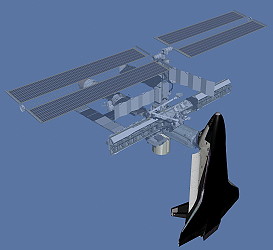 |
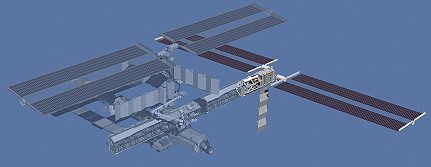 |
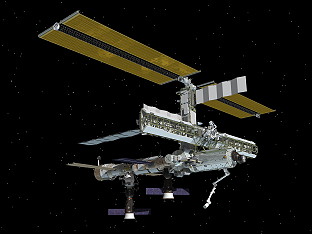 |
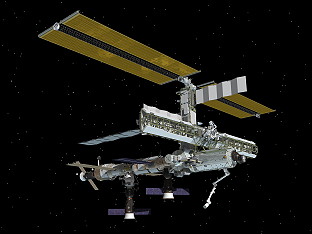 |
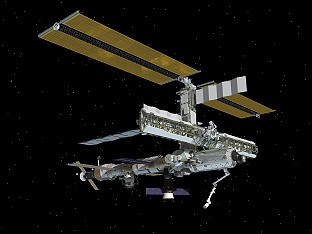 |
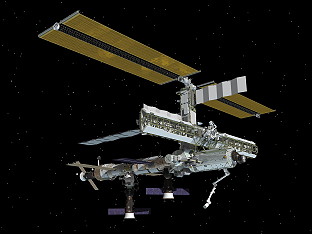 |
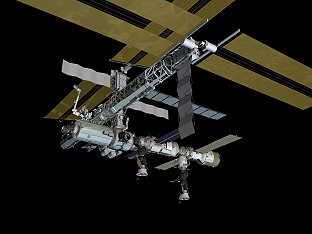 |
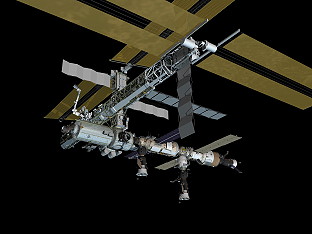 |
Photos / Graphics
 |
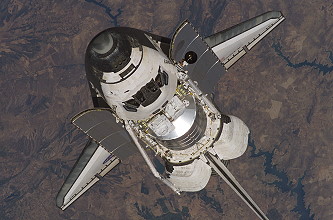 |
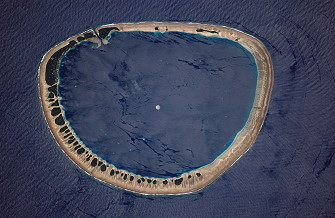 |
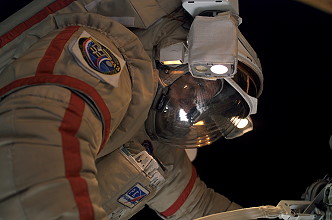 |
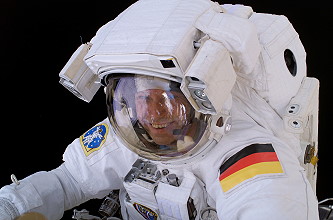 |
 |
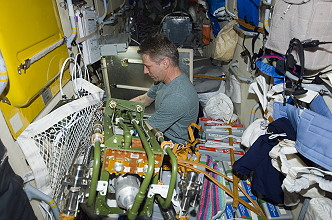 |
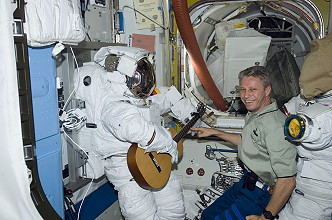 |
 |
 |
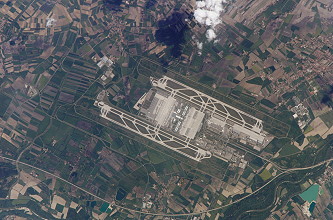 |
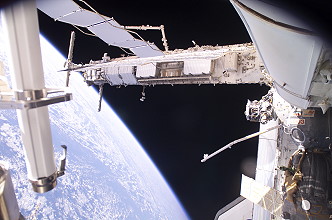 |
more Earth observation photos |
|
more EVA photos |
|
more onboard photos |
|
| © |  |
Last update on December 14, 2020.  |
 |